湖南简介PPT【英文版】
- 格式:ppt
- 大小:10.10 MB
- 文档页数:10
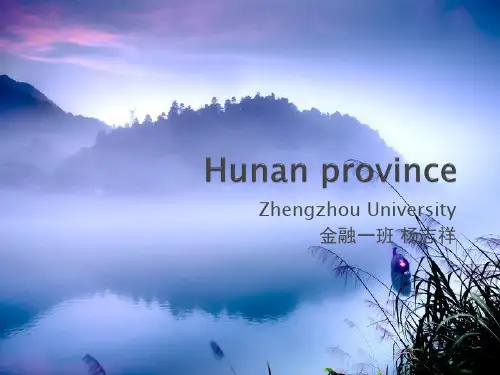

![长沙英文简介[优质ppt]](https://uimg.taocdn.com/9085889e7375a417876f8f63.webp)

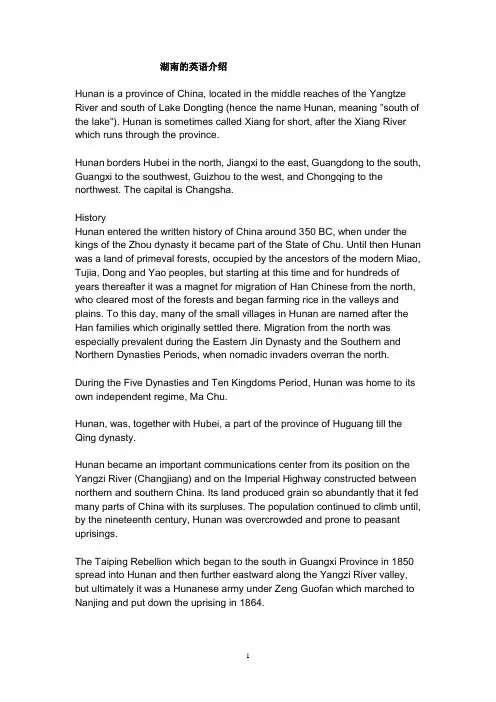
湖南的英语介绍Hunan is a province of China, located in the middle reaches of the Yangtze River and south of Lake Dongting (hence the name Hunan, meaning "south of the lake"). Hunan is sometimes called Xiang for short, after the Xiang River which runs through the province.Hunan borders Hubei in the north, Jiangxi to the east, Guangdong to the south, Guangxi to the southwest, Guizhou to the west, and Chongqing to the northwest. The capital is Changsha.HistoryHunan entered the written history of China around 350 BC, when under the kings of the Zhou dynasty it became part of the State of Chu. Until then Hunan was a land of primeval forests, occupied by the ancestors of the modern Miao, Tujia, Dong and Yao peoples, but starting at this time and for hundreds of years thereafter it was a magnet for migration of Han Chinese from the north, who cleared most of the forests and began farming rice in the valleys and plains. To this day, many of the small villages in Hunan are named after the Han families which originally settled there. Migration from the north was especially prevalent during the Eastern Jin Dynasty and the Southern and Northern Dynasties Periods, when nomadic invaders overran the north.During the Five Dynasties and Ten Kingdoms Period, Hunan was home to its own independent regime, Ma Chu.Hunan, was, together with Hubei, a part of the province of Huguang till the Qing dynasty.Hunan became an important communications center from its position on the Yangzi River (Changjiang) and on the Imperial Highway constructed between northern and southern China. Its land produced grain so abundantly that it fed many parts of China with its surpluses. The population continued to climb until, by the nineteenth century, Hunan was overcrowded and prone to peasant uprisings.The Taiping Rebellion which began to the south in Guangxi Province in 1850 spread into Hunan and then further eastward along the Yangzi River valley, but ultimately it was a Hunanese army under Zeng Guofan which marched to Nanjing and put down the uprising in 1864.Hunan was relatively quiet until 1910 when there were uprisings against the crumbling Qing dynasty, which were followed by the Communist's Autumn Harvest Uprising of 1927 led by Hunanese native Mao Zedong, which established a short-lived Hunan soviet in 1927. The Communists maintained a guerilla army in the mountains along the Hunan-Jiangxi border until 1934, when under pressure from the Nationalist (Kuomintang, KMT) forces they began the famous Long March to bases in Shaanxi Province. After the departure of the Communists, the KMT army fought against the Japanese in the second Sino-Japanese war, defending the capital Changsha until it fell in 1944, when Japan launched Operation Ichigo to control the railroad from Wuchang to Guangzhou (Yuehan Railway). Hunan was relatively unscathed by the civil war that followed the defeat of the Japanese in 1945, and in 1949 the Communists returned once more as the Nationalists retreated southward.Being Mao Zedong's home province, Hunan supported the Cultural Revolution of 1966-1976, and was slower than most provinces in adopting the reforms implemented by Deng Xiaoping in the years that followed Mao's death in 1976.Former Chinese Premier Zhu Rongji is also Hunanese.GeographyHunan Province is located on the south bank of the Yangtze River (Changjiang, 长江), about half way along its length. Shanghai lies 1000 km away, Beijing 1200 km away, and Guangzhou 500 km away.Hunan is situated between 109°-114° east longitude and 20°-30° north latitude. The east, south and west sides of the province are surrounded by mountains and hills, such as the Wuling Mountains to the northwest, the Xuefeng Mountains to the west, the Nanling Mountains to the south, and the Luoxiao Mountains to the east. The mountains and hills occupy more than 80% of the area and the plain comprises less than 20% of the whole province.The Xiangjiang, the Zijiang, the Yuanjiang and the Lishui Rivers converge on the Yangtze River at Lake Dongting (Dongting Hu, 洞庭湖) in the north of Hunan. The center and northern parts are somewhat low and a U-shaped basin, open in the north and with Lake Dongting as its center. Most of Hunan Province lies in the basins of four major tributaries of the Yangtze River.Lake Dongting is the largest lake in the province and the second largest freshwater lake of China. Due to the reclamation of land for agriculture, Lake Dongting has been subdivided into many smaller lakes, though there is now atrend to reverse some of the reclamation, which had damaged wetland habitats surrounding the lake.Hunan's climate is subtropical, with mild winters and plenty of precipitation. January temperatures average 3 to 8°C while July temperatures average around 27 to 30°C. Average annual precipitation is 1200 to 1700 mm.EconomyHunan's traditional crop is rice. The Lake Dongting area is an important center of ramie production, and Hunan is also an important center of tea cultivation.The Lengshuijiang area is noted for its stibnite mines, and is one of the major centers of antimony extraction in China.Its nominal GDP for 2004 was 561.2 billion yuan (US$69.62 billion). In 2004, its per capita GDP was 8,423 yuan (US$1,040).。



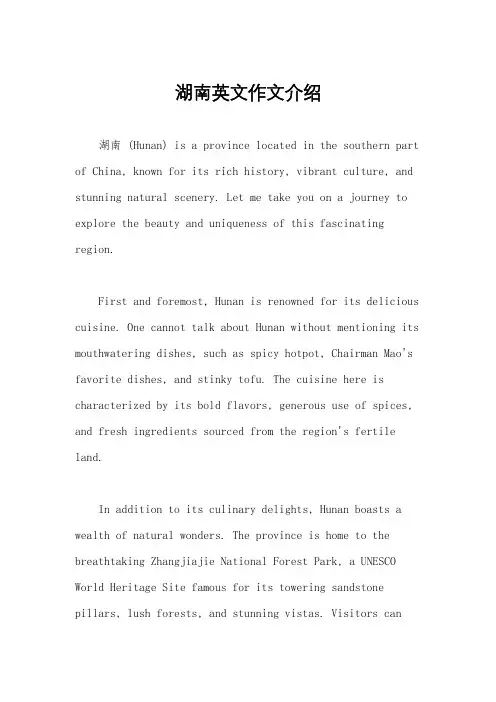
湖南英文作文介绍湖南 (Hunan) is a province located in the southern part of China, known for its rich history, vibrant culture, and stunning natural scenery. Let me take you on a journey to explore the beauty and uniqueness of this fascinating region.First and foremost, Hunan is renowned for its delicious cuisine. One cannot talk about Hunan without mentioning its mouthwatering dishes, such as spicy hotpot, Chairman Mao's favorite dishes, and stinky tofu. The cuisine here is characterized by its bold flavors, generous use of spices, and fresh ingredients sourced from the region's fertile land.In addition to its culinary delights, Hunan boasts a wealth of natural wonders. The province is home to the breathtaking Zhangjiajie National Forest Park, a UNESCO World Heritage Site famous for its towering sandstone pillars, lush forests, and stunning vistas. Visitors canexplore the park's numerous hiking trails, marvel at the gravity-defying Avatar Hallelujah Mountain, and soak in the serene beauty of the surrounding landscape.Moreover, Hunan is steeped in history and culture. The province is the birthplace of many influential figures in Chinese history, including Chairman Mao Zedong. Visitors can learn about Hunan's rich cultural heritage by exploring its ancient towns, traditional villages, and historic landmarks. The city of Changsha, the provincial capital, is home to the Hunan Provincial Museum, where artifacts dating back thousands of years are on display, offering insights into the region's past.Furthermore, Hunan is known for its vibrant festivals and celebrations. One of the most famous is the Dragon Boat Festival, held annually on the fifth day of the fifth lunar month. During this festival, colorful dragon boats race along the province's rivers and lakes, accompanied by the sound of beating drums and cheering crowds. It's a spectacle not to be missed and offers a glimpse into the local culture and traditions.In conclusion, Hunan is a province of diverse landscapes, rich history, and vibrant culture. Whether you're a food enthusiast, nature lover, history buff, or cultural explorer, Hunan has something to offer everyone. So why not plan your next adventure to this captivating region and experience all that it has to offer?。
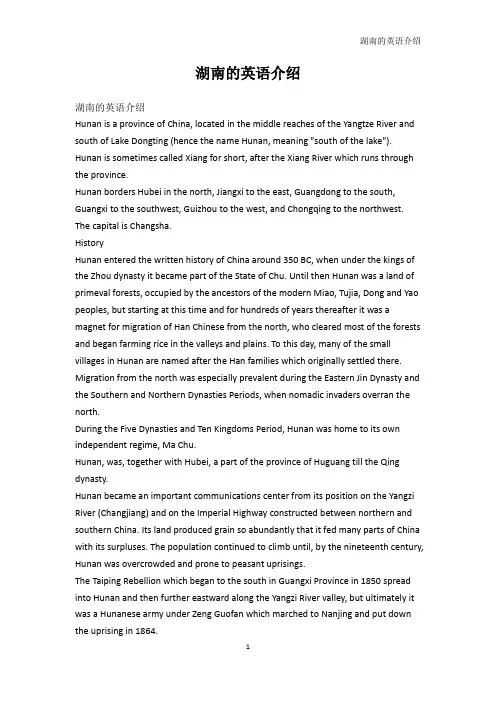
湖南的英语介绍湖南的英语介绍Hunan is a province of China, located in the middle reaches of the Yangtze River and south of Lake Dongting (hence the name Hunan, meaning "south of the lake"). Hunan is sometimes called Xiang for short, after the Xiang River which runs through the province.Hunan borders Hubei in the north, Jiangxi to the east, Guangdong to the south, Guangxi to the southwest, Guizhou to the west, and Chongqing to the northwest. The capital is Changsha.HistoryHunan entered the written history of China around 350 BC, when under the kings of the Zhou dynasty it became part of the State of Chu. Until then Hunan was a land of primeval forests, occupied by the ancestors of the modern Miao, Tujia, Dong and Yao peoples, but starting at this time and for hundreds of years thereafter it was a magnet for migration of Han Chinese from the north, who cleared most of the forests and began farming rice in the valleys and plains. To this day, many of the small villages in Hunan are named after the Han families which originally settled there. Migration from the north was especially prevalent during the Eastern Jin Dynasty and the Southern and Northern Dynasties Periods, when nomadic invaders overran the north.During the Five Dynasties and Ten Kingdoms Period, Hunan was home to its own independent regime, Ma Chu.Hunan, was, together with Hubei, a part of the province of Huguang till the Qing dynasty.Hunan became an important communications center from its position on the Yangzi River (Changjiang) and on the Imperial Highway constructed between northern and southern China. Its land produced grain so abundantly that it fed many parts of China with its surpluses. The population continued to climb until, by the nineteenth century, Hunan was overcrowded and prone to peasant uprisings.The Taiping Rebellion which began to the south in Guangxi Province in 1850 spread into Hunan and then further eastward along the Yangzi River valley, but ultimately it was a Hunanese army under Zeng Guofan which marched to Nanjing and put down the uprising in 1864.Hunan was relatively quiet until 1910 when there were uprisings against the crumbling Qing dynasty, which were followed by the Communist's Autumn Harvest Uprising of 1927 led by Hunanese native Mao Zedong, which established ashort-lived Hunan soviet in 1927. The Communists maintained a guerilla army in the mountains along the Hunan-Jiangxi border until 1934, when under pressure from the Nationalist (Kuomintang, KMT) forces they began the famous Long March to bases in Shaanxi Province. After the departure of the Communists, the KMT army fought against the Japanese in the second Sino-Japanese war, defending the capital Changsha until it fell in 1944, when Japan launched Operation Ichigo to control the railroad from Wuchang to Guangzhou (Yuehan Railway). Hunan was relatively unscathed by the civil war that followed the defeat of the Japanese in 1945, and in 1949 the Communists returned once more as the Nationalists retreated southward. Being Mao Zedong's home province, Hunan supported the Cultural Revolution of 1966-1976, and was slower than most provinces in adopting the reforms implemented by Deng Xiaoping in the years that followed Mao's death in 1976. Former Chinese Premier Zhu Rongji is also Hunanese.GeographyHunan Province is located on the south bank of the Yangtze River (Changjiang, 长江), about half way along its length. Shanghai lies 1000 km away, Beijing 1200 km away, and Guangzhou 500 km away.Hunan is situated between 109°-114° east longitude and 20°-30° north latitude. The east, south and west sides of the province are surrounded by mountains and hills, such as the Wuling Mountains to the northwest, the Xuefeng Mountains to the west, the Nanling Mountains to the south, and the Luoxiao Mountains to the east. The mountains and hills occupy more than 80% of the area and the plain comprises less than 20% of the whole province.The Xiangjiang, the Zijiang, the Yuanjiang and the Lishui Rivers converge on the Yangtze River at Lake Dongting (Dongting Hu, 洞庭湖) in the north of Hunan. The center and northern parts are somewhat low and a U-shaped basin, open in the north and with Lake Dongting as its center. Most of Hunan Province lies in the basins of four major tributaries of the Yangtze River.Lake Dongting is the largest lake in the province and the second largest freshwater lake of China. Due to the reclamation of land for agriculture, Lake Dongting has been subdivided into many smaller lakes, though there is now atrend to reverse some of the reclamation, which had damaged wetland habitats surrounding the lake.Hunan's climate is subtropical, with mild winters and plenty of precipitation. January temperatures average 3 to 8°C while July temperatures average around 27 to 30°C. Average annual precipitation is 1200 to 1700 mm.EconomyHunan's traditional crop is rice. The Lake Dongting area is an important center of ramie production, and Hunan is also an important center of tea cultivation.The Lengshuijiang area is noted for its stibnite mines, and is one of the major centers of antimony extraction in China.Its nominal GDP for 2004 was 561.2 billion yuan (US$69.62 billion). In 2004, its per capita GDP was 8,423 yuan (US$1,040).。
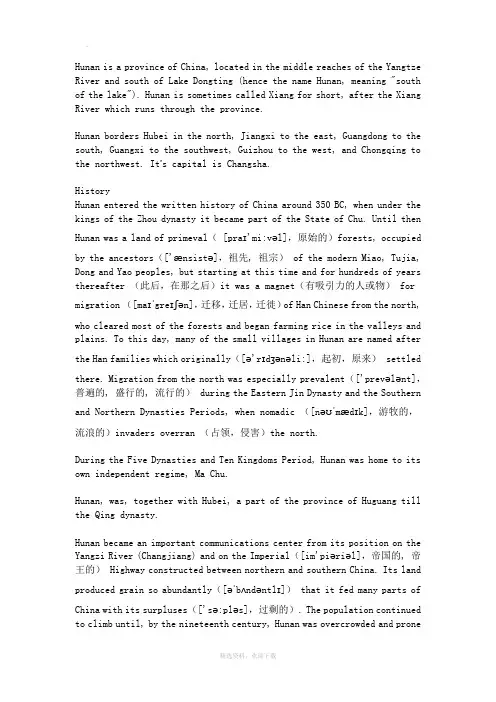
Hunan is a province of China, located in the middle reaches of the Yangtze River and south of Lake Dongting (hence the name Hunan, meaning "south of the lake"). Hunan is sometimes called Xiang for short, after the Xiang River which runs through the province.Hunan borders Hubei in the north, Jiangxi to the east, Guangdong to the south, Guangxi to the southwest, Guizhou to the west, and Chongqing to the northwest. It’s capital is Changsha.HistoryHunan entered the written history of China around 350 BC, when under the kings of the Zhou dynasty it became part of the State of Chu. Until thenHunan was a land of primeval( [praɪ'mi:vəl],原始的)forests, occupiedby the ancestors(['ænsistə],祖先, 祖宗) of the modern Miao, Tujia, Dong and Yao peoples, but starting at this time and for hundreds of years thereafter (此后,在那之后)it was a magnet(有吸引力的人或物) formigration ([maɪˈgreɪʃən],迁移,迁居,迁徙)of Han Chinese from the north,who cleared most of the forests and began farming rice in the valleys and plains. To this day, many of the small villages in Hunan are named afterthe Han families which originally([ə'rɪdʒənəli:],起初,原来) settledthere. Migration from the north was especially prevalent(['prevələnt],普遍的, 盛行的, 流行的) during the Eastern Jin Dynasty and the Southernand Northern Dynasties Periods, when nomadic ([nəʊˈmædɪk],游牧的,流浪的)invaders overran (占领,侵害)the north.During the Five Dynasties and Ten Kingdoms Period, Hunan was home to its own independent regime, Ma Chu.Hunan, was, together with Hubei, a part of the province of Huguang till the Qing dynasty.Hunan became an important communications center from its position on the Yangzi River (Changjiang) and on the Imperial([im'piəriəl],帝国的, 帝王的) Highway constructed between northern and southern China. Its landproduced grain so abundantly([əˈbʌndəntlɪ]) that it fed many parts ofChina with its surpluses(['sə:pləs],过剩的). The population continued to climb until, by the nineteenth century, Hunan was overcrowded and prone([prəun])to(倾于) peasant(['pezənt],农民,农夫) uprisings(起义,暴动).The Taiping Rebellion([ri'beliən]) which began to the south in Guangxi Province in 1850 spread into Hunan and then further eastward along theYangzi River valley, but ultimately([ˈʌltəmɪtli],最后,最终) it wasa Hunanese army under Zeng Guofan which marched to Nanjing and put down the uprising in 1864.Hunan was relatively (相对来说)quiet until 1910 when there were uprisings against the crumbling (['krʌmbl],衰落, 崩溃)Qing dynasty, which were followed by the Communist's([ˈkɔmjunist]) Autumn Harvest Uprising of1927 led by Hunanese native Mao Zedong, which established a short-lived Hunan soviet in 1927. The Communists maintained a guerilla army in the mountains along the Hunan-Jiangxi border until 1934, when under pressure from the Nationalist (Kuomintang, KMT) forces they began the famous Long March to bases in Shaanxi Province. After the departure of the Communists, the KMT army fought against the Japanese in the second Sino-Japanese war, defending the capital Changsha until it fell in 1944, when Japan launched Operation Ichigo to control the railroad from Wuchang to Guangzhou (Yuehan Railway). Hunan was relatively unscathed by the civil war that followed the defeat of the Japanese in 1945, and in 1949 the Communists returned once more as the Nationalists retreated southward.Being Mao Zedong's home province, Hunan supported the Cultural Revolution of 1966-1976, and was slower than most provinces in adopting the reforms implemented by Deng Xiaoping in the years that followed Mao's death in 1976.Former Chinese Premier (['premiə],总理,首相)Zhu Rongji is also Hunanese.Hunan's climate is subtropical([sʌbˈtrɔpɪkəl],亚热带的), with mild winters and plenty of precipitation( [prɪ,sɪpɪ'teɪʃən],降雨). Januarytemperatures average 3 to 8°C(degree) while July temperatures average around 27 to 30°C. Average annual precipitation is 1200 to 1700 mm (millimetre).EconomyHunan's traditional crop is rice. The Lake Dongting area is an important center of ramie (['ræmi],苎麻)production, and Hunan is also an important center of tea cultivation.The Lengshuijiang area is noted for its stibnite(['stibnait],辉锑矿)mines, and is one of the major centers of antimony extraction in China.Its nominal (名义上的)GDP for 2004 was 561.2 billion yuan . In 2004, its per capita GDP was 8,423 yuan.Of course, you must be very interested in Hunan Toutism,but time is limited, so I can just tell you some places which you can go to have a look. 5 stars are Zhangjiajie,Hengshan Mountain, the provincial museum, ancient city of Fenghuang(5星级的张家界南岳衡山省博物馆凤凰古城). 4 stars are Yueyang Tower, Junshan Island, Yuelu Hill, Orange Island, Wulingyuan, Meishan Long Gong, Bo-dong, Langshan, Shaoshan, Huaminglou(4星级的岳阳楼君山岛岳麓山橘子洲武陵源梅山龙宫波月洞崀山韶山花明楼).3 star has Shundi Ling, Emperor Yan, the East River reservoirs, ancient commercial city, Zhijiang War Memorial, Shek Mun Shan folder(3星级的舜帝陵炎帝陵东江水库洪江古商城芷江抗战纪念碑石门夹山).That’s all, thank you for your listening.Welcome !!! 欢迎您的下载,资料仅供参考!。